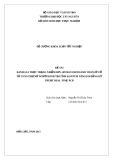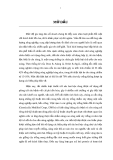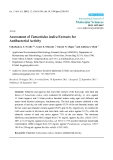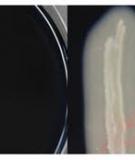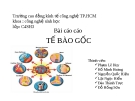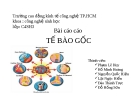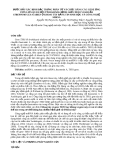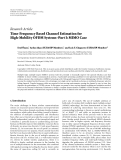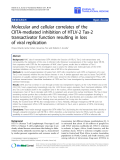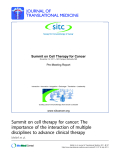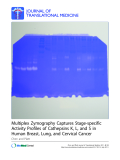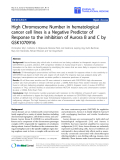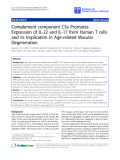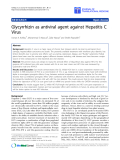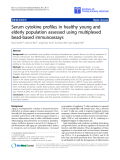Nuôi cấy tế bào Nhân sâm Panax ginseng trong
bioreactor: Vai trò của ôxy trong sản xuất sinh khối và
sản phẩm ginsenoside
Ảnh hưởng của nồng độ ôxy (20.8-50%) đến quá trình nuôi
cấy tế bào Panax ginseng đã được nghiên cứu trong
bioreactor hình cầu với dung tích 5l có chứa 4l môi trường
MS. Ở nồng độ ôxy 40% đã cho thấy là thích hợp cho việc
sản xuất sinh khối và sản phẩm ginsenoside với kết quả thu
được là 12.8 g/L sinh khối khô, và 4.5 mg/g SKK
ginsenoside vào ngày thứ 25. Các nồng độ ôxy 20.8, 30 và
50% là không thích hợp cho quá trình nuôi cấy tế bào cũng
như sự tích lũy sản phẩm ginsenoside. Kết quả trên đây
cũng chỉ ra rằng ôxy là nhân tố hữu hiệu trong sản xuất
sinh khối và sản phẩm ginsenoside ở quy mô lớn hơn.
I. ABSTRACT
The effects of oxygen supply within the range of 20.8%-
50% (along with purified air), on high-density cell culture
of Panax ginseng were investigated in an balloon type
bioreactor (5 l capacity and containing 4 l of MS medium).
A 40% oxygen supply was found optimal for the
production of cell mass and ginsenoside with corresponding values of 12.8 g l-1 DW, 4.5-mg/g DW on
day 25, respectively. A low (20.8%, 30%) and well as high
concentration of oxygen (50%) supply was unfavorable to
the cell cultures and they affect the cell growth and
ginsenoside accumulation. The results indicate that oxygen
is a key factor in scaling up the process of suspension
cultures of Panax ginseng and supplementation of oxygen
is useful for efficient large-scale production of ginsenosides
by the submerged cultures.
II. INTRDUCTION
Plants are an abundant source of a large number of useful
products including pharmaceutical and food additives.
Plant cell cultures are an alternative source to whole plant
for the production of high-value secondary metabolites.
During the past decade, a considerable progress has been
made to stimulate formation and accumulation of
secondary metabolites using plant cell cultures (Rao and
Ravishankar, 2002). Ginseng (Panax ginseng C. A. Meyer),
a member of Araliaceae, is traditionally considered one of
the most potent medicinal plants. Ginsenosides have been
regarded as the most important active components in
ginseng roots and are attributed with cardio-protective,
immunomodulatory, anti-fatigue, and hepato-protective
physiological and pharmacological effects (Zhang and
Zhong, 1997).
In recent years, plant cells are cultured in large-scale
bioreactors for production of secondary metabolites
including pharmaceuticals, pigments, and other chemicals
(Rao and Ravishankar, 2002). Growth and accumulation of
secondary metabolites in large-scale bioreactors is
influenced by various factors such as shear stress, oxygen
supply, and gas composition. A conventional stirred-tank
bioreactor can produce a high shear region, while in many
cases airlift and bubble column reactors are used for
providing shear environment compared to turbine-agitated
reactors. As reported, oxygen supply is also significant in
affecting secondary metabolites formation in cell cultures
(Gao and Lee, 1992; Zhong et al., 1993; Han and Zhong,
2003). Gas exchange between the gas and liquid phases is
another important factor that may affect the scale-up of
plant cell cultures. In bioreactors, forced aeration is needed
to supply oxygen and to improve fluid mixing. However, it
may also lead to the removal of some known (such as CO2
and ethylene) or unknown gaseous compounds. Such
gaseous metabolites were proven or suggested to be
important for cell growth and/or synthesis of secondary
metabolites in plant cell cultures (Gao and Lee, 1992).
The concentration of dissolved oxygen can be easily
controlled in bubble/airlift bioreactors and interaction
between O2 supply, cell growth and metabolite biosynthesis
can be observed. In this study, we have used balloon type
bioreactors for cell cultures of ginseng and the interaction
between oxygen supply, cell growth, and ginsenoside
production was investigated. The significance of gas
control during bioreactor culture has been established and
this study is considered useful for biotechnological
application ginseng cell cultures to the production of
ginsenosides on a large scale.
III. MATERIALS AND METHODS
Induction and proliferation of callus
Six-year-old fresh ginseng roots (Panax ginseng C. A.
Meyer) were sterilized and cultured as described by Yu,
(2000).
Bioreactor cultures
A five-liter capacity balloon type bioreactors were used
containing 4 l of MS (Murashige, Skoog, 1962) medium
working volume with the culture condition as described by
Thanh et al., (2004; 2005) to increase the biomass. Sixty
grams cell fresh weight per liter was added as inoculum. In
the bubble bioreactor, a sinter glass was used for aeration,
and the airflow rate was adjusted during cultivation to
homogenous mixing state. To investigate the effects of
different levels of oxygen in the inlet air, air was mixed
with different concentrations of oxygen i.e., 20.8%
(control), 30%, 40%, and 50%. The schematic diagram of
the whole experimental system is shown in Fig. 1. The cultivation temperature was controlled at 25±2oC and
continuous darkness was maintained. Three identical
cultivation vessels were operated under each condition, and
the cultivation data shown represent average values with
standard deviations. The bioreactor cultures were
maintained up to 30 days.
Sampling and analyses of cell weight, medium sugar,
conductivity
A sample of 30 ml of cell culture was taken once from each
bioreactor at an interval of every five days. The cell
suspensions were filtered and washed several times with
distilled water for the measurement of cell weights (fresh
and dry weights). The culture supernatants were used for
analysis residual sugar, using HPLC by following
analytical procedures described by Zhang and Zhong,
(1997) and Woragidbum-rang et al., (2001). The electrical
conductivity was from the exhausted medium using
conductivity meter Wiss-teelm-werkstalten model LF-54
(WTW GmbH, Wielhalm, Germany).
Fig. 1. Schematic diagram of the balloon type bioreactor
culture system used in the present study: a. body of a
balloon type bioreactor, b. air vent, c. inoculum port, d.
sampling port, e. medium exchange port, f. air flow meter,
g. membrane filter, h. water column, i. air compressor, j. air
reservoir, k. air cooler, l. filter system, m. air dryer, n.
oxygen tank.
Determination of ginsenoside content
Ginsenoside (saponin) content was determined by HPLC,
and the details have been described elsewhere (Furuya and
Yoshikawa, 1987; William and John, 1996).
IV. RESULTS AND DISCUSSION
Effect of oxygen concentration on cell growth
Fig. 2 shows the growth kinetics of P. ginseng cells in 4 l
balloon type bioreactors as influenced by four different
levels of oxygen supply. The cell growth and biomass
accumulation is gradually increased with lapse of time and
optimum biomass accumulation reached after 25 days.
Similar growth kinetics pattern was reported in P.
notoginseng in shake flask, centrifugal impeller bioreactor
and turbine reactors cultures (Zhong et al., 1999). The
maximum fresh weight with the supply of 20.8% oxygen
(control) was 267 g l-1 and corresponding dry weight was 11.5 g l-1 (Fig. 2A-B). It was found that optimum accumulation of fresh (316 g l-1) and dry biomass (12.8 g l- 1) was with the supply 40% oxygen in the bioreactors. The
biomass accumulation comparatively declined with the increase in oxygen concentration to 50% (255 g l-1 FW and 9.0 g l-1DW).
Fig. 2. Time profiles of fresh cell weight (A), dry cell
weight (B) in high-density culture
of Panax ginseng cells in a 5 l balloon type bioreactor.
Electrical conductivity measurements (EC) have been used
as an indirect method of biomass estimation in continuous
on line monitoring of plant cell cultures in bioprocess
engineering studies for its accuracy and efficiency (Ryu et
al., 1994). The electrical conductivity of the medium, also
which reflects the uptake of medium salts (ions) by the
cultured cells and linear decrease, was observed with
increase in cell density during cultivation (Fig. 3A). In the
cell cultures, which were supplied with 40% oxygen,
showed a decrease in EC values from initial value of 5.6
mS/cm to 1.23 mS/cm (Fig. 3A). At the beginning of
cultivation, the cell growth was slow and in a lag phase,
and subsequently cells involved in division and
multiplication and hence due to the active metabolic uptake
of the medium ions by the cultured cells. Similarly,
observations were recorded with P. notoginseng (Zhong et
al., 1999) and rice (Wen and Zhong, 1996) suspension
cultures.
Time profiles of medium sugar consumption at different
levels O2 supply are shown in Fig. 3B. After inoculation,
cells in all cases gradually consumed sugar and residual
sugar concentration was almost exhausted when cell
growth reached peak. The growth yield (on sucrose) at 50% O2 supply was lower than that of control (11.5 g l-1 versus 9.5 g l-1 on day 25) and it means that carbon flux was
altered by O2 concentration. A similar phenomenon has
also been reported during cell culture in Catharathus roseus
(Tate and Payne, 1991) and in P. notoginseng (Han and
Zhong, 2003).
Fig. 3. Time profiles of medium conductivity (A), residual
sugar (B) in high-density cultures
of Panax ginseng cells in a 5 l balloon type bioreactor.
Effect of oxygen concentration on metabolite
production
The kinetic profile of total ginsenosides (saponin)
production is shown in Fig. 4. Highest saponin
accumulation was on day 20 to 25 and later it declined.
Saponin content at 50% O2 supply was lower than that of
control (20% O2 supply). The maximum total saponin
concentrations were 3.8 mg/g DW, 4.4 mg/g DW, 4.5 mg/g
DW and 2.85 mg/g DW at 20.8%, 30%, 40% and 50% O2
supply, respectively (Fig. 4). Highest saponin production
was with 40% O2 supply and lowest with 50% O2 supply.
Supplementation of oxygen to the high-density suspension
cultures significantly affects the accumulation of
ginsenosides and these results are concurrence with earlier
published reports (Gao and Lee, 1992; Zhong et al., 1993).
High cell density and fluid viscosity could significantly
reduced oxygen transfer efficiencies in bioreactors and
conventional way of improving oxygen transfer rate is to
increase agitation speed and/or aeration rate (Huang and
Chou, 2000). However, these approaches have several
limitations, such as high power consumption, cell damage
due to mechanical shear stress, potential reduction of
productivity because of the stripping of CO2 and other
essential volatiles from the system. An alternative approach
is improving the quality of incoming air by with oxygen
concentration. In the present experiment we have
supplemented the incoming air with different ratios of pure
oxygen, which facilitates oxygen transfer rates, improves
the accumulation of biomass of cultured cell and in turn
accumulation of metabolites.
Fig. 4. Kinetics of production of ginseng saponin of Panax
ginseng cells in high-density bioreactor cultivations.
V. REFERENCES
1. Gao JW, Lee JM (1992). Effect of oxygen supply on the
suspension culture of genetically modified tobacco cells.
Biotcehnol. Prog. 8: 285-90.
2. Furuya T, Yoshikawa T (1987). Saponin production by
cultures of P. ginseng transformed with Agrobacterium
rhizogens. Plant Cell Rep. 6: 449-453.
3. Han J, Zhong JJ (2003). Effects of oxygen partial
pressure on cell growth and ginsenoside and polysaccharide
production in high-density cell cultures of P. notoginseng.
Enzyme Microb. Tech. 32: 498-503.
4. Huang SY and Chou CJ (2000). Effect of gaseous
composition on cell growth and secondary metabolite
production in suspension culture of Stizolobium hassjoo
cell. Bioproce. Engineer., 23: 585-593.
5. Murashige T, Skoog F (1962) A revised medium for
rapid growth and bioassays with tobacco tissue cultures.
Plant Physiol. 15: 473-497.
6. Rao SR, Ravishankar GA (2002). Plant cell cultures:
Chemical factories of secondary metabolites. Biotech. Adv.
20: 101-153.
7. Ryu DY, Lee Schlatmann JE, Fonck E, ten Hoopen HJG,
Heijnen JJ (1994). The negligible role of carbon dioxide
and ethylene in ajmaliceine production by Catharanthus
roseus cell suspensions. Plant Cell Rep. 14: 157-60.
8. Tate JL, Payne GF (1991). Plant cell growth under
different levels of oxygen and carbon dioxide. Plant Cell
Rep. 10: 22-25.
9. Thanh NT (2005). Factors affecting cell growth and
ginsenoside production in P. ginseng C. A. Meyer. Ph.D.
Dissertation, Chungbuk National University, Cheongju,
South Korea.
10. Thanh NT., Murthy HN, Yu KW, Hahn EJ and Paek
KY (2004). Methyl jasmonate elicitation enhanced
synthesis of ginsenoside by cell suspension cultures of P.
ginseng in 5-l balloon type bubble bioreactors. Appl.
Microb. Biotechnol., ISSN: 0175-7598 (Paper) 1432-0614
(Online).
11. Wen ZY, Zhong JJ (1996). Correlation between
biomass and medium conductivity in suspension cultures of
rice cells. Biotechnol. Tech. 10: 309-312.
12. William A, Jhon G, Hendel J (1996). Reversed-phase
high performance liquid chromatographic determination of
ginsenosides of P. quinquefolium. J. Chromatog. 77: 11-17.
13. Woragidbum-rang K, Sae-Tang P, Yao H, Han J,
Chauvatchrin S, Zhong JJ (2001). Impact of conditioned
medium on cell cultures of P. notoginseng in air-lift
bioreactors. Process Biochem. 37: 209-313.
14. Yu KW (2000). Production of useful metabolites
through bioreactor culture of Korean ginseng (P. ginseng C.
A. Meyer), Ph. D. Dissertation, Chungbuk National
University, Cheongju, Korea.
15. Zhang YH, Zhong JJ (1997). Hyper-production of
ginseng saponin and polysaccharide by high-density
cultivation of P. notoginseng cells. Enzyme Microb. Tech.
21: 59-63.
16. Zhong JJ, Chen F, Hu WW (1999). High-density
cultivation of P. notoginseng cells in stirred bioreactors for
the production of ginseng biomass and ginseng saponin.
Process Biochem. 35: 491-496.
17. Zhong JJ, Yoshida M, Fujiyama K, Seki T, Yoshida T
(1993). Enhancement of anthocyanin production by Perilla
frutescens cells in stirred bioreactor with internal light
irradiation. J. Ferment. Bioeng. 75: 299-303.

